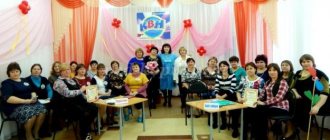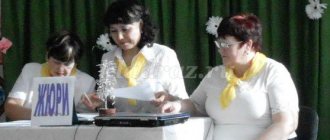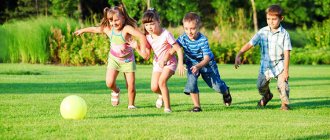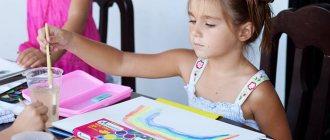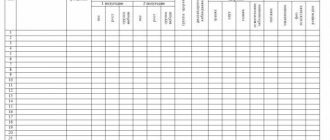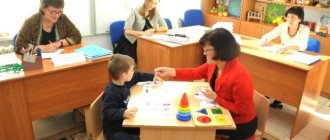"Protection and promotion of children's health"
Author: Pastorok Maria Anatolyevna
Protecting and promoting children's health is one of the main tasks facing kindergartens and families. Teachers introduce parents to the daily routine in a preschool institution and give recommendations on organizing the daily routine in the family. The daily routine affects the physical development and health of the baby. It is necessary to continue working in the family to develop self-care skills in children. Teachers recommend effective methods that are appropriate to the age of children: demonstration, explanation, personal example of loved ones, encouragement to imitate, use of play techniques. In conversations with parents, educators emphasize the need for them to maintain constant restraint, patience, and respect for the child’s personality. The teacher recommends that each family create the conditions necessary for the child’s full development and upbringing, purchase a table and chair according to the child’s height, allocate a place for games and activities, and identify a beautiful hanger for outerwear. In a conversation with parents, the teacher gives advice on the order in which the child should put on and take off clothes, how to behave at the table, how to hold a spoon, etc. Among the children there are those who suffer from poor appetite, you should consult a pediatrician. You cannot entertain children with toys or reading while eating; It is impossible to teach a child to eat a lot of sweets from an early age, they weaken the immune system, the body’s resistance to disease, and diabetes may develop.
It is necessary to invite parents to the kindergarten to observe the children during breakfast, lunch, dressing, etc. This should be done in the first days of visiting the kindergarten in order to facilitate the child’s adaptation period, which is often accompanied by the child’s illness. The teacher advises taking children home earlier than expected to give them the opportunity to get used to new living conditions; you can bring your favorite toy or book with you to kindergarten.
Lack of awareness of parents in matters of child health can be the cause of his frequent illnesses. Therefore, individual work with each family is necessary. Excessive overheating of babies is harmful. Full walks depend on how children are dressed. The teacher pays attention to this and gives advice. Children should move, walk, run and play outdoor games. The teacher draws the family's attention to the organization of the child's sleep: what time does he go to bed in the evening, how long does he sleep, is the TV on, etc. Lack of sleep leads to the development of childhood neurosis. You can allow the child to take a soft toy with him to bed, the touch of which causes a state of peace, warmth, and encourages sleep, but do not allow the child to play in bed. It is unacceptable for parents to smoke in the room where the child is.
The family has great opportunities for the moral education of younger preschoolers. It’s not too early to present them with moral standards and teach them rules of behavior. For many parents, the basis for raising children at this age are taboos: “don’t touch,” “don’t get dirty,” “you can’t,” etc. The teacher introduces parents to the tasks of moral education of children, which are important to solve in community.
Moral education must begin from an early age, when behavioral habits are easy to form: be polite, get used to being busy, respect elders, show care, learn the norms of communication, speech, facial expressions, gestures, respect the work of others, be kind to the adult children around you. Teachers advise parents with one child in the family to invite home friends from kindergarten or neighbors to play. Parents should not yell at the child, they should talk calmly, say good night, good morning, and thank them for their help.
Educators attract parents to kindergarten to prepare for the holidays. The joint work of the kindergarten and the family makes it possible to optimally solve the problems of the harmonious development of children.
Daily regime. A single daily routine is recommended for all children in the third year of life. At the same time, it is necessary to ensure, throughout the entire period of active wakefulness, a rational alternation of various types of activities, including an appropriate amount of mental, physical and emotional stress for the children’s age, as well as proper rest. It is carried out depending on the health status of each child, especially his nervous system and level of development. When developing self-care skills in children, they should be provided with constant assistance. When accepting a child to kindergarten, the teacher asks parents about his well-being and behavioral characteristics. If a disease is suspected, it is necessary to provide the child with a medical examination.
Catering. The main requirement is strict regularity and timeliness - the basis for a good appetite in a child. Prepared food is delivered in a special, labeled, sealed container. The nanny thoroughly washes her hands with soap, puts on a clean robe and scarf, and washes the tables with hot water and soap. The teacher makes sure that children wash their hands with soap and wipe them dry. Meals should always take place in a calm environment.
Organization of sleep. Before children go to bed, the room is well ventilated; depending on the weather, the windows are left open during sleep; during sleep, there should be silence in the room; loud conversations, screams, and noisy outdoor games are unacceptable; It is important for children to have pajamas and cotton shirts.
Organization of a walk. Games and nature observations are organized on the site. It is important that children do not become overheated or cooled down. Children's play activities during a walk should be under the control and guidance of a teacher.
Organization of classes. The correct organization of educational activities with children of primary preschool age provides for a playful form, extensive use of visual material, and motor aspects that contribute to the most effective development of children and prevent fatigue.
Classes should be interesting in content and varied in structure, taking into account the age characteristics of children.
Hardening. Aimed at improving the body's defense reactions, increasing resistance to diseases and resistance to temperature fluctuations. An effective form of air hardening is a walk in the morning, when children are exposed to ultraviolet radiation. Healthy children are hardened by the sun during games in a zone of light and shade and diffused sunlight. Children are gradually introduced to water procedures, starting with local douches and wet rubdowns. First, they teach you to wash your face, wash your hands (up to the elbow, your neck with water at room temperature. Then they move on to special procedures. Dousing the feet is carried out after a day's sleep (temperature not lower than 20 degrees). General douching (showering) in the warm period of the year is required after a walk, then hardening acts as a hygienic procedure.
Depending on the health status of the children and in consultation with the doctor, you can start swimming in open reservoirs, where the water depth is up to the child’s waist and the bottom is clean and level.
Swimming is carried out under the supervision of two adults: one in the water with children, the other on the shore. Children should move and play in the water. Cooling should not be allowed. In this case, the child is taken out of the water, rubbed with a towel until the skin turns pink and changed into dry underwear. If children have been in an area illuminated by direct sunlight for a long time, swimming should not be done immediately.
A game.
Story-based role-playing games. The teacher, in a joint game with the child, teaches him the simplest play actions, how to feed a doll or a bear, rock them, put them to bed. For games, you should select simple plots with one or two characters and basic actions: the driver loads the car with cubes and drives it, the mother pushes her daughter in a stroller and feeds her. The teacher comes up with stories himself or uses literary texts: short stories, poems. For example, “It’s time to sleep, the bull fell asleep and lay down in his crib on his side”, “The sleepy bear lay down in bed, but the elephant doesn’t want to sleep”, “Both the doll and the bunny also want to sleep” comments powered by HyperComments
Chapter 1
Chapter 2
Chapter 3
Chapter 4
Chapter 5
Article 1. Subject of regulation of this Federal Law
Article 2. Basic concepts used in this Federal Law
Article 3. Basic principles of state policy and legal regulation of relations in the field of education
Article 4. Legal regulation of relations in the field of education
Article 5. Right to education. State guarantees of the realization of the right to education in the Russian Federation
Article 6. Powers of federal government bodies in the field of education
Article 7. The powers of the Russian Federation in the field of education, transferred for implementation to state authorities of the constituent entities of the Russian Federation
Article 8. Powers of state authorities of the constituent entities of the Russian Federation in the field of education
Article 9. Powers of local government bodies of municipal districts and city districts in the field of education
Article 10. Structure of the education system
Article 1. Subject of regulation of this Federal Law
Article 2. Basic concepts used in this Federal Law
Article 3. Basic principles of state policy and legal regulation of relations in the field of education
Article 4. Legal regulation of relations in the field of education
Article 5. Right to education. State guarantees of the realization of the right to education in the Russian Federation
Article 6. Powers of federal government bodies in the field of education
Article 7. The powers of the Russian Federation in the field of education, transferred for implementation to state authorities of the constituent entities of the Russian Federation
Article 8. Powers of state authorities of the constituent entities of the Russian Federation in the field of education
Article 9. Powers of local government bodies of municipal districts and city districts in the field of education
Article 10. Structure of the education system
Article 1. Subject of regulation of this Federal Law
Article 2. Basic concepts used in this Federal Law
Article 3. Basic principles of state policy and legal regulation of relations in the field of education
Article 4. Legal regulation of relations in the field of education
Article 5. Right to education. State guarantees of the realization of the right to education in the Russian Federation
Article 6. Powers of federal government bodies in the field of education
Article 7. The powers of the Russian Federation in the field of education, transferred for implementation to state authorities of the constituent entities of the Russian Federation
Article 8. Powers of state authorities of the constituent entities of the Russian Federation in the field of education
Article 9. Powers of local government bodies of municipal districts and city districts in the field of education
Article 10. Structure of the education system
Article 1. Subject of regulation of this Federal Law
Article 2. Basic concepts used in this Federal Law
Article 3. Basic principles of state policy and legal regulation of relations in the field of education
Article 4. Legal regulation of relations in the field of education
Article 5. Right to education. State guarantees of the realization of the right to education in the Russian Federation
Article 6. Powers of federal government bodies in the field of education
Article 7. The powers of the Russian Federation in the field of education, transferred for implementation to state authorities of the constituent entities of the Russian Federation
Article 8. Powers of state authorities of the constituent entities of the Russian Federation in the field of education
Article 9. Powers of local government bodies of municipal districts and city districts in the field of education
Article 10. Structure of the education system
Article 11. Federal state educational standards and federal state requirements. Educational standards
Article 12. Educational programs
Article 13. General requirements for the implementation of educational programs
Article 14. Language of education
Article 15. Network form of implementation of educational programs
Article 16. Implementation of educational programs using e-learning and distance learning technologies
Article 17. Forms of education and forms of training
Article 18. Printed and electronic educational and information resources
Article 19. Scientific, methodological and resource support for the education system
Article 20. Experimental and innovative activities in the field of education
Article 21. Educational activities
Article 22. Creation, reorganization, liquidation of educational organizations
Article 23. Types of educational organizations
Article 24. Moscow State University named after M.V. Lomonosov, St. Petersburg State University. Categories of educational organizations of higher education
Article 25. Charter of an educational organization
Article 26. Management of an educational organization
Article 27. Structure of an educational organization
Article 28. Competence, rights, duties and responsibilities of an educational organization
Article 29. Information openness of an educational organization
Article 30. Local regulations containing norms regulating educational relations
Article 31. Organizations providing training
Article 32. Individual entrepreneurs carrying out educational activities
Article 33. Students
Article 34. Basic rights of students and measures of their social support and incentives
Article 35. Use of textbooks, teaching aids, teaching and educational means
Article 36. Scholarships and other monetary payments
Article 37. Catering for students
Article 38. Students’ clothing. Uniforms and other clothing (uniforms) of students
Article 39. Provision of residential premises in dormitories
Article 40. Transport support
Article 41. Health protection of students
Article 42. Psychological, pedagogical, medical and social assistance to students experiencing difficulties in mastering basic general education programs, development and social adaptation
Article 43. Duties and responsibilities of students
Article 44. Rights, duties and responsibilities in the field of education of parents (legal representatives) of minor students
Article 45. Protection of the rights of students, parents (legal representatives) of minor students
Article 46. The right to engage in teaching activities
Article 47. Legal status of teaching staff. Rights and freedoms of teaching staff, guarantees of their implementation
Article 48. Duties and responsibilities of teaching staff
Article 49. Certification of teaching staff
Article 50. Scientific and pedagogical workers
Article 51. Legal status of the head of an educational organization. President of an educational organization of higher education
Article 52. Other employees of educational organizations
Article 11. Federal state educational standards and federal state requirements. Educational standards
Article 12. Educational programs
Article 13. General requirements for the implementation of educational programs
Article 14. Language of education
Article 15. Network form of implementation of educational programs
Article 16. Implementation of educational programs using e-learning and distance learning technologies
Article 17. Forms of education and forms of training
Article 18. Printed and electronic educational and information resources
Article 19. Scientific, methodological and resource support for the education system
Article 20. Experimental and innovative activities in the field of education
Article 21. Educational activities
Article 22. Creation, reorganization, liquidation of educational organizations
Article 23. Types of educational organizations
Article 24. Moscow State University named after M.V. Lomonosov, St. Petersburg State University. Categories of educational organizations of higher education
Article 25. Charter of an educational organization
Article 26. Management of an educational organization
Article 27. Structure of an educational organization
Article 28. Competence, rights, duties and responsibilities of an educational organization
Article 29. Information openness of an educational organization
Article 30. Local regulations containing norms regulating educational relations
Article 31. Organizations providing training
Article 32. Individual entrepreneurs carrying out educational activities
Article 33. Students
Article 34. Basic rights of students and measures of their social support and incentives
Article 35. Use of textbooks, teaching aids, teaching and educational means
Article 36. Scholarships and other monetary payments
Article 37. Catering for students
Article 38. Students’ clothing. Uniforms and other clothing (uniforms) of students
Article 39. Provision of residential premises in dormitories
Article 40. Transport support
Article 41. Health protection of students
Article 42. Psychological, pedagogical, medical and social assistance to students experiencing difficulties in mastering basic general education programs, development and social adaptation
Article 43. Duties and responsibilities of students
Article 44. Rights, duties and responsibilities in the field of education of parents (legal representatives) of minor students
Article 45. Protection of the rights of students, parents (legal representatives) of minor students
Article 46. The right to engage in teaching activities
Article 47. Legal status of teaching staff. Rights and freedoms of teaching staff, guarantees of their implementation
Article 48. Duties and responsibilities of teaching staff
Article 49. Certification of teaching staff
Article 50. Scientific and pedagogical workers
Article 51. Legal status of the head of an educational organization. President of an educational organization of higher education
Article 52. Other employees of educational organizations
Article 11. Federal state educational standards and federal state requirements. Educational standards
Article 12. Educational programs
Article 13. General requirements for the implementation of educational programs
Article 14. Language of education
Article 15. Network form of implementation of educational programs
Article 16. Implementation of educational programs using e-learning and distance learning technologies
Article 17. Forms of education and forms of training
Article 18. Printed and electronic educational and information resources
Article 19. Scientific, methodological and resource support for the education system
Article 20. Experimental and innovative activities in the field of education
Article 21. Educational activities
Article 22. Creation, reorganization, liquidation of educational organizations
Article 23. Types of educational organizations
Article 24. Moscow State University named after M.V. Lomonosov, St. Petersburg State University. Categories of educational organizations of higher education
Article 25. Charter of an educational organization
Article 26. Management of an educational organization
Article 27. Structure of an educational organization
Article 28. Competence, rights, duties and responsibilities of an educational organization
Article 29. Information openness of an educational organization
Article 30. Local regulations containing norms regulating educational relations
Article 31. Organizations providing training
Materials 1 - 150 of 475 Home |
Prev. | 1
| Track. | End | All
